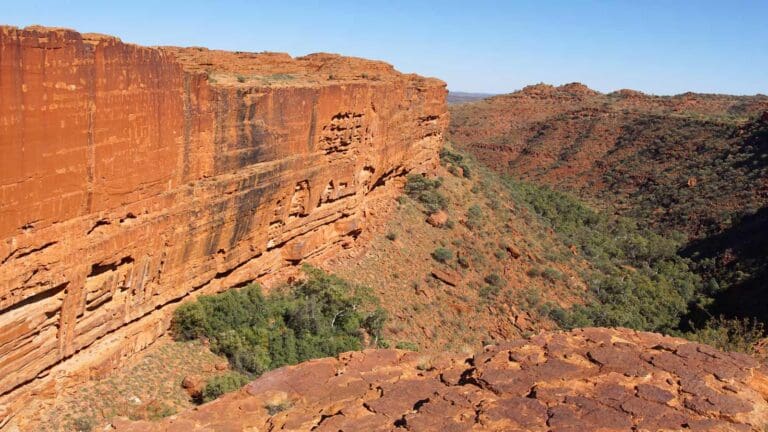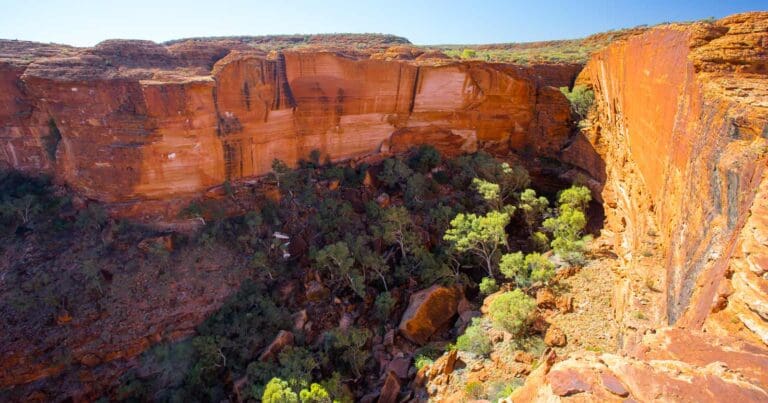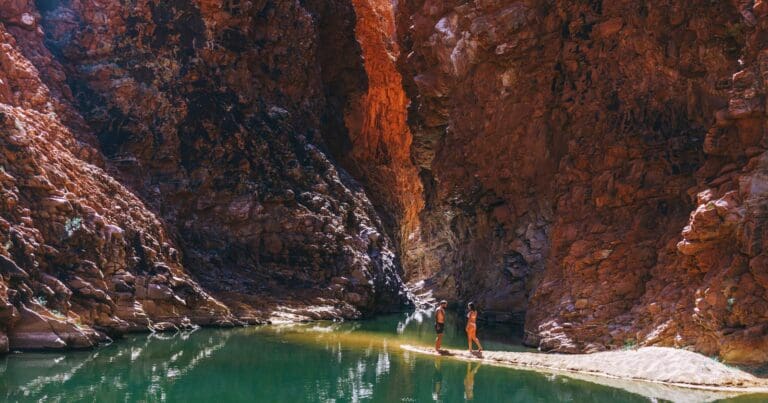Trail Fast Facts
Uluru Base Walk is an 11km, grade 3 hike in Uluru-Kata Tjuta National Park, Northern Territory. This hike typically takes 3 hours to complete.
Hike Overview
Uluru, also known as Ayers Rock, stands as a majestic monolith in the heart of Australia, captivating visitors with its spiritual significance and geological wonder. The Uluru Base Walk offers a unique opportunity to immerse yourself in this awe-inspiring landscape. This moderately challenging 11km hike encircles the base of Uluru, allowing you to discover the rich tapestry of nature, culture, and Aboriginal storytelling that imbues this sacred place.
Tailor Your Trek: Exploring Uluru at Your Pace.
The beauty of the Uluru Base Walk lies in its flexibility. The trail can be adapted to your fitness level and time constraints.
Mala Walk: A Journey Through Dreamtime - Embark on a cultural and historical exploration on the Mala Walk. This section, often included in ranger-guided tours, follows the path taken by the Mala people, the traditional inhabitants of this area. Explore ancient caves that served as their home and marvel at the intricate rock art depicting stories from Aboriginal Dreamtime. The walk culminates in the serene Kantju Gorge, a place of profound peacefulness.
Kuniya Walk to Mutitjulu Waterhole: A Life-Sustaining Oasis - Delve deeper into the heart of Uluru with the Kuniya Walk. This path leads you to the Mutitjulu Waterhole, one of the few permanent water sources around Uluru. The presence of water fosters a lush and vibrant ecosystem, where you might spot wallabies grazing amidst the tall grasses and river red gum trees. Keep your eyes peeled for native bush foods like tjantu (bush tomatoes), ili (figs), and arnguli (bush plums) that thrive in this area. Mutitjulu Waterhole holds deep cultural significance for the Anangu Traditional Owners, and you might even encounter a commemorative plaque marking visits by dignitaries like the British Royals and the Dalai Lama. Take a moment to soak in the tranquility of the waterhole; the sound of trickling water and chirping birds will undoubtedly leave you feeling rejuvenated.
Lungkata Walk: A Geological Marvel - For those seeking a more immersive experience with the rock itself, the Lungkata Walk is the perfect choice. This idyllic track allows you to walk right next to Uluru, reaching out to touch its ancient textures. Look skyward and marvel at the spectacular elevated caves and crevices, sculpted by millennia of wind and water erosion. These crevices provide a haven for a diverse range of birdlife, making the Lungkata Walk a feast for both the eyes and ears.
The Uluru Base Walk is an experience that will stay with you forever. Prepare to be humbled by the beauty and power of Uluru and gain a deeper appreciation for the traditional custodians of this land.
Beyond the Base Walk: The Liru Walk, though not part of the base walk, offers a unique perspective. This track winds through a vibrant mulga forest, leading to a hidden viewpoint with breathtaking Uluru views.
Track Grade
Grade 3 (Moderate) - Walks for Most Fitness Levels: Grade 3 on the AWTGS represents moderate walking tracks. These are ideal for walkers with some fitness who are comfortable with some hills and uneven terrain. While suitable for most ages, some bushwalking experience is recommended to ensure a safe and enjoyable experience. Tracks may have short, steep hill sections, a rough surface, and many steps. The total distance of a Grade 3 walk can be up to 20 kilometers.
Tips
- Beat the Heat: Start your walk early in the morning, especially during summer, to avoid extreme temperatures.
- Respect the Culture: Certain sections of the walk hold deep cultural significance for the Anangu Traditional Owners. Be mindful and respectful.
- Stay Hydrated: Carry plenty of water and stay hydrated throughout the hike.
- Walk Smart: Wear comfortable shoes, sun protection, and a hat.
Map and GPX file
Max elevation: 616 m
Min elevation: 507 m
Total climbing: 243 m
Total descent: -243 m
Trailhead
Sorry, no records were found. Please adjust your search criteria and try again.
Sorry, unable to load the Maps API.
Getting there
Fly: Yulara has its own airport, called Ayers Rock/Connellan Airport (airport code AYQ). You can fly directly to Yulara from a number of Australian cities, including Sydney, Melbourne, Brisbane, Darwin, Adelaide and Alice Springs. Approximate flight times are:
- Alice Springs to Yulara: 45 minutes
- Adelaide to Yulara: 2 hours
- Darwin to Yulara: 2 hours 15 minutes
- Sydney to Yulara: 3 hours
- Melbourne to Yulara: 2 hours 30 minutes
- Brisbane to Yulara: 3 hours 15 minutes
If you're travelling from overseas or another Australian city, your flight will probably connect via one of the cities above.
Drive: Many visitors come to the park as part of a road trip around outback Australia. The famous Red Centre Way is a multi-day drive of this extraordinary region, taking in Uluru-Kata Tjuta National Park, Watarrka (Kings Canyon), Tjoritja (West MacDonnell Ranges), Alice Springs and more. You can find out more on the Tourism NT website. Uluru is 465 km from Alice Springs by road. If you are driving directly this should take about 5.5 hours.
About the region
The ancient red rock formations of Kata Tjuta rise from the dusty land to make an incredible sight in Central Australia. Witness the spectacular rocks as they appear to change colour and immerse yourself in the Aboriginal stories of this special place, 500 million years in the making.
Kata Tjuta is a group of large, ancient rock formations about 30 kilometres (18.6 miles) away from Uluru in Australia's Red Centre. Together, these giant stone formations form the two major landmarks within the Uluru-Kata Tjuta National Park. Kata Tjuta is made up of 36 domes spread over an area of more than 20 kilometres (12.4 miles). The highest point is Mount Olga, named in honour of Queen Olga of Württemberg by the explorer Ernest Giles.
Suggest an edit
Spotted a change on this trail? Maybe there are new features, the route has shifted, or the trail is permanently closed. Whatever the update, I’d love your input. Your feedback helps fellow hikers stay informed and ensures that our trail info stays fresh and reliable.
Similar trails nearby
Looking for things to do in Uluru-Kata Tjuta National Park or nearby? Try these similar hikes or bushwalks.
Let someone know
Adventure with Confidence: Register Your Trip Plans
Before you hit the trail, take a moment to fill out our trip intentions form. It’s a simple way to share important details about your hike with family or friends. If things don’t go as planned and you’re not back on time, they can easily notify emergency services, helping to ensure a quick response and reducing worry. Enjoy your outdoor adventure knowing that you’ve taken a smart step for your safety.
Gear to consider
What you carry in your pack will depend on the weather, terrain, time of year, type of adventure, and personal preferences. Having trouble deciding what gear’s right for you? My free planning, food and packing checklists provide an introduction to things your could consider (as well as the Ten Essentials) on your day, overnight and multi-day adventures. Customise your kit according to your personal needs, always considering safety first.
Explore Safe
While planning your hike, it’s important to check official government sources for updated information, temporary closures and trail access requirements. Before hitting the trail, check local weather and bushfire advice for planned burns and bushfire warnings and let someone know before you go. Plan ahead and hike safely.
Weather
Acknowledgement of Country
Trail Hiking Australia acknowledges the Traditional Owners of the lands on which we hike and pay respects to their Elders, past and present, and we acknowledge the First Nations people of other communities who may be here today.







1 Review on “Uluru Base Walk (11km)”
Out of the three hikes we did at Uluru, the base walk offered a different perspective compared to the others (namely the Kings Canyon Rim and the Olgas Valley of the Winds).
While being close to Uluru is awe-inspiring, some parts of the base walk can feel less engaging. The initial section is a significant distance from the rock and offers minimal shade. However, the diverse wildflowers along the trail were a pleasant surprise.
In my opinion, the highlight of the walk is between the two carparks (likely the Lungkata section). Here, you’re close to Uluru’s base, surrounded by beautiful eucalyptus trees and birdsong. If you’re unsure about completing the entire loop, this section is a great option.
The total distance is roughly 10-11 kilometers, and it took us 2 and a half hours, including plenty of photo breaks and a side trip to Kantju Gorge. We began at a moderate pace but picked it up towards the end (scenic flight back from Ayers Rock Resort loomed!).
The walk itself is flat and easy. The main challenge is the lack of shade, so be prepared for extended sun exposure. Regular athletic shoes are perfectly suitable.